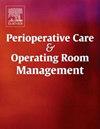Shivering after spinal anesthesia and associated factors in mothers undergoing cesarean delivery at a referral hospital in northcentral Ethiopia: In resource-limited settings
IF 1
Q2 Nursing
Perioperative Care and Operating Room Management
Pub Date : 2025-04-19
DOI:10.1016/j.pcorm.2025.100491
引用次数: 0
Abstract
Background
Post-spinal anesthesia shivering is one of the potential complications of anesthesia which may increase patient morbidity. Little is known about the incidence and associated factors of post-spinal shivering in our country. This study aims to assess the magnitude of post-spinal anesthesia shivering and its associated factors among mothers who underwent cesarean section at Debre Tabor Comprehensive Specialized Hospital, Ethiopia.
Methods
A Hospital-based cross-sectional study was conducted on a total of 113 patients who underwent cesarean section under spinal anesthesia. A systematic random sampling method was employed to select 113 study subjects. A structured questionnaire was used to collect data. Bivariable and multivariable logistic regression were used to show an association between independent variables and the dependent variable (post-spinal anesthesia shivering). Variables with a p-value of less than 0.2 were transformed into multivariate analysis. The odds ratios with 95 % CI and p-values of less than 0.05 were used to show the strength of association and level of significance.
Results
The overall incidence of post-spinal shivering was 39 (34.5 %) and variables such as not administering intrathecal pethidine 3.01 (AOR=3.01; 95 % CI: 1.08,8.40), blood loss 500–1000 ml (AOR=4.02;95 % CI: 1.46,11.07), co-loading with less 500 ml (AOR=4.97;95 % CI: 1.48,16.72), intraoperative maternal hypothermia(AOR=4.17;95 % CI: 1.44,12.10) were significantly associated with post-spinal anesthesia shivering.
Conclusions
The overall incidence of post-spinal anesthesia shivering in the study area was 39 (34.5 %). We suggest the introduction of the post-spinal anesthesia shivering management protocol.
在埃塞俄比亚中北部一家转诊医院接受剖宫产的母亲在脊髓麻醉后的颤抖和相关因素:在资源有限的情况下
背景:脊髓麻醉后寒战是麻醉的潜在并发症之一,可能增加患者的发病率。我国对脊髓后寒战的发病率及相关因素了解甚少。本研究旨在评估在埃塞俄比亚Debre Tabor综合专科医院接受剖宫产手术的母亲中脊髓麻醉后颤抖的程度及其相关因素。方法对113例脊柱麻醉下剖宫产术患者进行横断面研究。采用系统随机抽样的方法,选取113名研究对象。采用结构化问卷收集数据。使用双变量和多变量逻辑回归来显示自变量和因变量(脊髓麻醉后颤抖)之间的关联。p值小于0.2的变量转换为多变量分析。使用95% CI和p值小于0.05的优势比来显示关联强度和显著性水平。结果脊髓后寒战的总发生率为39例(34.5%),未使用鞘内哌替啶等变量为3.01例(AOR=3.01;95% CI: 1.08,8.40),失血量500 - 1000 ml (AOR=4.02, 95% CI: 1.46,11.07),共负荷小于500 ml (AOR=4.97, 95% CI: 1.48,16.72),术中产妇体温过低(AOR=4.17, 95% CI: 1.44,12.10)与脊髓麻醉后寒战显著相关。结论研究区脊髓麻醉后寒战发生率为39例(34.5%)。我们建议引入脊髓麻醉后寒战管理方案。
本文章由计算机程序翻译,如有差异,请以英文原文为准。
求助全文
约1分钟内获得全文
求助全文
来源期刊

Perioperative Care and Operating Room Management
Nursing-Medical and Surgical Nursing
CiteScore
1.30
自引率
0.00%
发文量
52
审稿时长
56 days
期刊介绍:
The objective of this new online journal is to serve as a multidisciplinary, peer-reviewed source of information related to the administrative, economic, operational, safety, and quality aspects of the ambulatory and in-patient operating room and interventional procedural processes. The journal will provide high-quality information and research findings on operational and system-based approaches to ensure safe, coordinated, and high-value periprocedural care. With the current focus on value in health care it is essential that there is a venue for researchers to publish articles on quality improvement process initiatives, process flow modeling, information management, efficient design, cost improvement, use of novel technologies, and management.
 求助内容:
求助内容: 应助结果提醒方式:
应助结果提醒方式:


